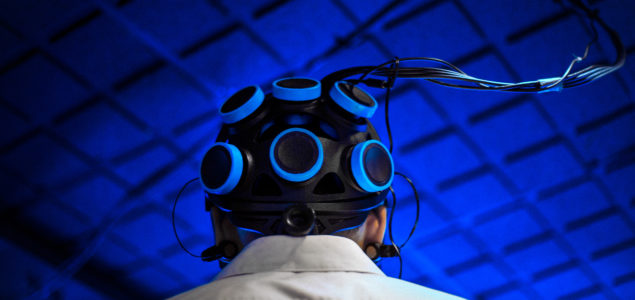A new partnership between Neurable and VRgineers adds the former’s “brain sensors” to the ultra high-end XTAL VR headset.
We tried out Neurable last year, a system which places EEG (Electroencephalography) sensors along the interior of a VR headset’s strap to gather data from contact with the skin around the brain. Combining that information in real-time with eye-tracking could allow the system to identify, measure and analyze the emotion and intent of the person wearing the headset. The XTAL VR headset from VRgineers includes eye tracking, so adding the EEG sensors and using Neurable’s analysis software might offer customers with very large budgets more capable analysis and training tools than consumer grade systems like Rift and Vive.
“We anticipate that this will be an enterprise-grade device, built for professional designers and engineers who require superior visual quality and highly accurate, reliable analytics,” Neurable CEO Ramses Alcaide explained in an email. “We’ve seen a lot of traction in three main areas: high-consequence simulation training for industrial applications, design feedback in AEC [Architecture, Engineering and Construction] use cases, customer research for retail.”

VRgineers claim,”Neurable’s unique ability to overcome the signal-to-noise issues of traditional non-invasive” brain-computer interfaces “enable them to deliver on the promise of truly useful BCI technology for enterprise and consumer applications.”
The expected use cases for the system make sense for the XTAL headset, which starts around $5,500 for its ultra-high end features which include a higher resolution panel, expanded field of view and integrated Leap Motion hand tracking. There’s no word yet on when the headset with Neurable integration will be available, or how much it will cost.
The military is investing nearly half a billion dollars in Microsoft-built HoloLens AR headsets to help soldiers become more effective while Walmart purchased 17,000 Oculus Go VR headsets this year to train the workforce at every store. If businesses are able to realize savings (or increased profits) by implementing VR training, then the high up-front cost of a headset like XTAL is likely still worth the investment. While we tried XTAL earlier this year and Neurable last year, and came away impressed by aspects of both demos, we haven’t tried a demo with both of these technologies implemented together.
“VR is a medium that relishes in data. Making sense of all of that data both from an input/output perspective is very important,” Alcaide explained. “Eye-tracking allows systems to parse a user’s virtual reality experience (i.e. when and where they are looking) while BCI provides data on the internal experience of the user (e.g. change in cognitive state state). With both data streams, we can extract powerful behavioral insights from virtual reality not available otherwise. It’s not enough to just see where a user is looking. We need to know what kind of changes are going on while they do so. Similarity, it’s not enough to just know general changes in state. Being able to programmatically associate the two data streams is how we bring value to these new types of applications.”

























